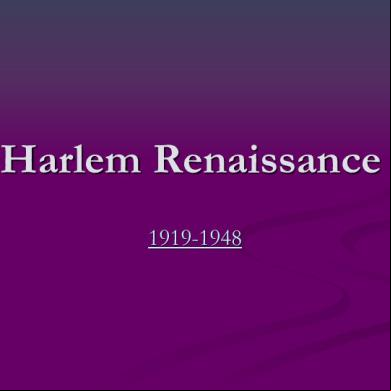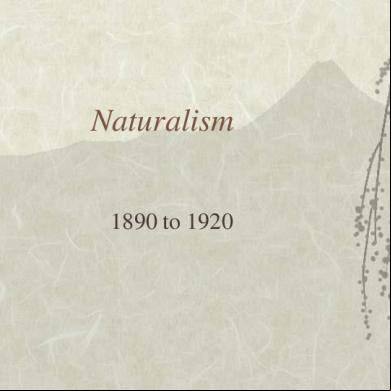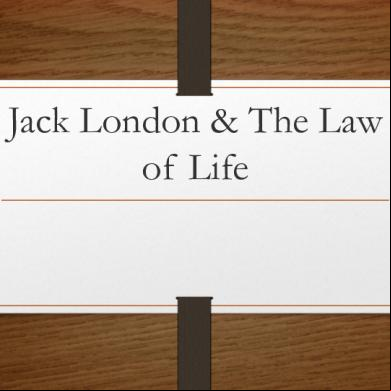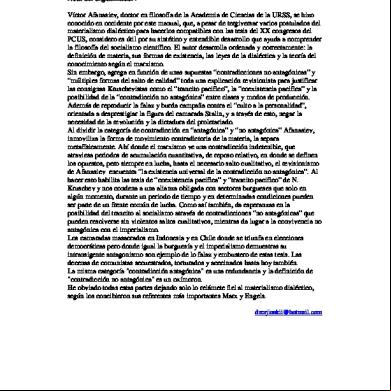Harlem Renaissance 3p424u
This document was ed by and they confirmed that they have the permission to share it. If you are author or own the copyright of this book, please report to us by using this report form. Report 3b7i
Overview 3e4r5l
& View Harlem Renaissance as PDF for free.
More details w3441
- Words: 1,072
- Pages: 27
Harlem Renaissance 1919-1948
WHAT IS THE HARLEM RENAISSANCE? It
was a time of great development of art, literature, music and culture in the AfricanAmerican Community. It is also known as the New Negro Movement.
Where Is Harlem?
HARLEM, NEW YORK
What led to the Harlem Renaissance?
From 1910 to 1930, African-Americans left their southern homes. Racism and lack of economic opportunities led them to leave the South. They were searching for better lives.
They migrated to urban centers like New York, Chicago, Detroit, and Cleveland.
The Artists from the Harlem Renaissance ERA Aaron Douglass (May 26, 1899 – February 3, 1979)
The Artists from the Harlem Renaissance ERA Augusta Savage (February 29, 1892 – March 26, 1962)
Gamin.
"Lift Every Voice and Sing."
The Artists from the Harlem Renaissance ERA Palmer C. Hayden (January 15, 1890 – February 18, 1973)
The Baptism
Midsummer Night In Harlem
The Artists from the Harlem Renaissance ERA Lois Mailou Jones (November 3, 1905 – June 9, 1998)
The Ascent of Ethiopia
Les Fetiches
The Artists from the Harlem Renaissance ERA
William Henry Johnson (March 18, 1901–1970)
I Baptize Thee Portrait of boy Moon over Harlem
The Artists from the Harlem Renaissance ERA Jacob Lawrence (September 7, 1917 – June 9, 2000)
The Great Migration Series
The Artists from the Harlem Renaissance ERA Archibald John Motley, Junior (October 7, 1891 – January 16, 1981)
Cocktails
Mending Socks The Artist's Grandmother
Black Belt
The Harlem Renaissance Literary movement
Started from a demographic movement called the “Great Migration” Consisted of Millions of black farmers moving to communities in the Urban North. They wanted to escape oppression and racism while searching for economic opportunities. Many of them settled in Harlem a racially diverse district of New York City.
Africans relied on a mixture between their heritage and their newfound experiences in the urban world to create a new form of expressive art. Africans worked together to abandon their traditional identity in favor of a new artistic identity. Renaissance means “rebirth” and the Harlem Renaissance was how many blacks transitioned from victims of the past to free thinkers.
Themes of the Harlem Renaissance
There are generally three themes of the Harlem Renaissance 1. The experience of blacks/ racial relations in America 2. Criticism of aspects of society (racial inequality, society, religion, institutions, etc) 3. Working towards the future.
Group Questions
1. How do you think people in this group viewed the future? Why do you think they had this perspective 2. What do you think blacks experienced when they lived in the American south? In what ways was this different from the north? What led to this relationship? 3. How do you feel these renaissance writers viewed society? What do you think they thought about religion and Christianity in particular?
Langston Hughes backstory
The music and dance and intellectual life of Harlem, inspired Langston more than his classes in mining engineering, and eventually he quit college. Meanwhile he sent poems to The Crisis.
Having difficulty finding work, Hughes, twentyone years old, ed the crew of a ship sailing for Africa. Eventually he traveled through Italy, Holland, Spain, and , writing all the while.
Finally he returned to New York, and felt as though he had returned home.
A prolific writer—he began by writing poetry— he also wrote novels, short stories, essays, articles, and plays.
Race
was at the center of Hughes’ works—the beauty, dignity, and heritage of African Americans. Langston Hughes attempted to speak to all Americans—especially on the issues of social, economic, and political justice.
I, Too
I, Too, Sing America
Too means also, in this case he is alluding/responding to Walt Whitman’s poem “I Hear America Singing” When we hear the word sing we think of a song but in this case it sing should be thought of as “to praise”
nd 2
stanza
“Darker brother” refers to the speaker’s black skin. It is important to notice that he calls nonblacks his brothers. Here he acknowledges racial differences without saying race separates people.
“They Send me to eat in the kitchen/ when company comes” Here Hughes describes the inequality that exists in society. Who is they in this line? What type of role is the speaker suggesting he does? What is he saying is the social status of black people at this time?
But I laugh/ And eat well/ And grow strong The speaker responds to this treatment with determination and acceptance. He does not allow the inequality to control his life
Tomorrow,/ I’ll be at the table/ When company comes. Would you describe this perspective of the future as positive or negative? How do you think the speaker expects to achieve his dream of sitting at the table?
Nobody’ll dare/ Say to me,/ “Eat in the Kitchen,”/Then The line nobody’ll dare implies fear or overpowering. This is not negative or violent but it suggests the way to eliminate inequality is through the empowerment of the black community. Ending with the word “then” shows how focused the narrator is on the equality that will exist in the future.
Besides,/ They’ll see how beautiful I am/ And be ashamedThe poem ends with a reflection on himself that changes the tone of the previous stanza. The first stanza focuses on the problems of the present. The second focuses on what will be great in the future. And the third stanza removes the speaker from the unjust world around him.
Earlier the speaker says “Nobody’ll dare” yet in the final stanza he becomes less aggressive and more romantic. He believes that the people that mistreated African Americans will feel ashamed in the future for how badly they treated black people in the past. Do you think this actually happened?
Questions
1. Is the poem’s vision of the future/ racial relations a positive one? 2. Why do you think Hughes created the poem? Who do you think was his ideal audience for the poem? 3. Who is the speaker in the poem supposed to be? Who is he speaking to? 4. Do you think the speaker’s vision is something that has been attained or is attainable in the future?
WHAT IS THE HARLEM RENAISSANCE? It
was a time of great development of art, literature, music and culture in the AfricanAmerican Community. It is also known as the New Negro Movement.
Where Is Harlem?
HARLEM, NEW YORK
What led to the Harlem Renaissance?
From 1910 to 1930, African-Americans left their southern homes. Racism and lack of economic opportunities led them to leave the South. They were searching for better lives.
They migrated to urban centers like New York, Chicago, Detroit, and Cleveland.
The Artists from the Harlem Renaissance ERA Aaron Douglass (May 26, 1899 – February 3, 1979)
The Artists from the Harlem Renaissance ERA Augusta Savage (February 29, 1892 – March 26, 1962)
Gamin.
"Lift Every Voice and Sing."
The Artists from the Harlem Renaissance ERA Palmer C. Hayden (January 15, 1890 – February 18, 1973)
The Baptism
Midsummer Night In Harlem
The Artists from the Harlem Renaissance ERA Lois Mailou Jones (November 3, 1905 – June 9, 1998)
The Ascent of Ethiopia
Les Fetiches
The Artists from the Harlem Renaissance ERA
William Henry Johnson (March 18, 1901–1970)
I Baptize Thee Portrait of boy Moon over Harlem
The Artists from the Harlem Renaissance ERA Jacob Lawrence (September 7, 1917 – June 9, 2000)
The Great Migration Series
The Artists from the Harlem Renaissance ERA Archibald John Motley, Junior (October 7, 1891 – January 16, 1981)
Cocktails
Mending Socks The Artist's Grandmother
Black Belt
The Harlem Renaissance Literary movement
Started from a demographic movement called the “Great Migration” Consisted of Millions of black farmers moving to communities in the Urban North. They wanted to escape oppression and racism while searching for economic opportunities. Many of them settled in Harlem a racially diverse district of New York City.
Africans relied on a mixture between their heritage and their newfound experiences in the urban world to create a new form of expressive art. Africans worked together to abandon their traditional identity in favor of a new artistic identity. Renaissance means “rebirth” and the Harlem Renaissance was how many blacks transitioned from victims of the past to free thinkers.
Themes of the Harlem Renaissance
There are generally three themes of the Harlem Renaissance 1. The experience of blacks/ racial relations in America 2. Criticism of aspects of society (racial inequality, society, religion, institutions, etc) 3. Working towards the future.
Group Questions
1. How do you think people in this group viewed the future? Why do you think they had this perspective 2. What do you think blacks experienced when they lived in the American south? In what ways was this different from the north? What led to this relationship? 3. How do you feel these renaissance writers viewed society? What do you think they thought about religion and Christianity in particular?
Langston Hughes backstory
The music and dance and intellectual life of Harlem, inspired Langston more than his classes in mining engineering, and eventually he quit college. Meanwhile he sent poems to The Crisis.
Having difficulty finding work, Hughes, twentyone years old, ed the crew of a ship sailing for Africa. Eventually he traveled through Italy, Holland, Spain, and , writing all the while.
Finally he returned to New York, and felt as though he had returned home.
A prolific writer—he began by writing poetry— he also wrote novels, short stories, essays, articles, and plays.
Race
was at the center of Hughes’ works—the beauty, dignity, and heritage of African Americans. Langston Hughes attempted to speak to all Americans—especially on the issues of social, economic, and political justice.
I, Too
I, Too, Sing America
Too means also, in this case he is alluding/responding to Walt Whitman’s poem “I Hear America Singing” When we hear the word sing we think of a song but in this case it sing should be thought of as “to praise”
nd 2
stanza
“Darker brother” refers to the speaker’s black skin. It is important to notice that he calls nonblacks his brothers. Here he acknowledges racial differences without saying race separates people.
“They Send me to eat in the kitchen/ when company comes” Here Hughes describes the inequality that exists in society. Who is they in this line? What type of role is the speaker suggesting he does? What is he saying is the social status of black people at this time?
But I laugh/ And eat well/ And grow strong The speaker responds to this treatment with determination and acceptance. He does not allow the inequality to control his life
Tomorrow,/ I’ll be at the table/ When company comes. Would you describe this perspective of the future as positive or negative? How do you think the speaker expects to achieve his dream of sitting at the table?
Nobody’ll dare/ Say to me,/ “Eat in the Kitchen,”/Then The line nobody’ll dare implies fear or overpowering. This is not negative or violent but it suggests the way to eliminate inequality is through the empowerment of the black community. Ending with the word “then” shows how focused the narrator is on the equality that will exist in the future.
Besides,/ They’ll see how beautiful I am/ And be ashamedThe poem ends with a reflection on himself that changes the tone of the previous stanza. The first stanza focuses on the problems of the present. The second focuses on what will be great in the future. And the third stanza removes the speaker from the unjust world around him.
Earlier the speaker says “Nobody’ll dare” yet in the final stanza he becomes less aggressive and more romantic. He believes that the people that mistreated African Americans will feel ashamed in the future for how badly they treated black people in the past. Do you think this actually happened?
Questions
1. Is the poem’s vision of the future/ racial relations a positive one? 2. Why do you think Hughes created the poem? Who do you think was his ideal audience for the poem? 3. Who is the speaker in the poem supposed to be? Who is he speaking to? 4. Do you think the speaker’s vision is something that has been attained or is attainable in the future?










